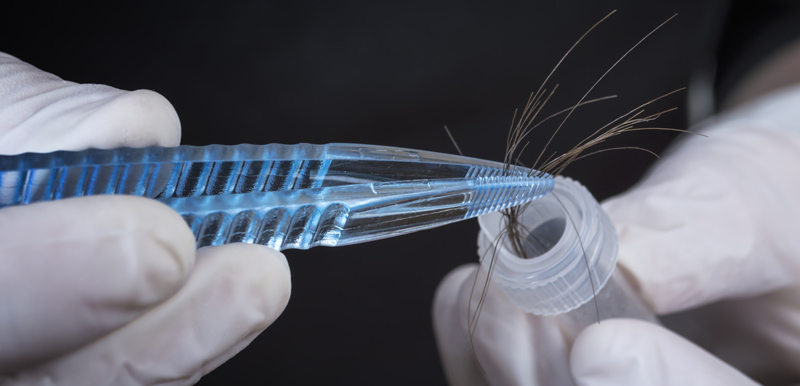Do you need to confirm a relationship? Curious to know how hair DNA testing works? In this blog, we’ll guide you through how DNA from hair can be used for testing, the advantages, the drawbacks, and more.
Can You Do a DNA Test with Hair?
Using hair as a DNA source for testing has been common practice for decades. Hair is made up of a protein called keratin, and at the root of each hair is a follicle, which contains DNA. When a hair is plucked, often the DNA-containing follicle is removed with it. Access to the hair follicle DNA is one of the most critical aspects of testing.
Technicians can use the DNA found in hair follicles for a variety of tests, including:
- Paternity Testing
- Forensic Identification
- Drug Testing
- Medical Testing
- And More
How Does DNA Testing with Hair Work?
A sample of multiple hairs (7-10) with intact follicles is necessary to achieve the best results from a hair DNA test. To ensure a hair sample has the necessary follicles attached, it is vital to look at the end of the hair closely. A hair with an intact follicle will appear slightly thicker at the root end, and you will see a tiny light-coloured bulb called a dermal papilla. After the testing provider receives the hair sample, they can begin processing it for DNA extraction.
Normally, the DNA within the hair sample will be amplified or copied so that there is enough of it to be analysed. The amplification of DNA is achieved through a process called polymerase chain reaction (PCR). PCR works by repeatedly heating and cooling DNA. When DNA is heated, it separates into two single strands. Next, an enzyme called “Taq polymerase” is introduced to the sample. This enzyme synthesises and uses the original DNA strands to “build” two new strands of DNA. Technicians can repeat this process many times, producing millions of copies of the original DNA.
With paternity testing, a laboratory technician would compare the extracted DNA from the alleged father’s hair to the child’s DNA. They would analyse the two DNA samples and look for similarities. From there, they could determine a probability of paternity based on either the presence or absence of similarities in the DNA.
The Advantages of a Hair DNA Test
Using hair as a sample for DNA testing is a method that has been around for many years. Below are some of the advantages that a hair DNA test provides.
It’s Great for People Unable to Provide a Cheek Swab
Hair DNA testing is completely non-invasive, meaning that it is a great option when a tested party (adult or child) is uncomfortable with providing a cheek swab. The non-invasive aspect of hair testing makes it a more comfortable and convenient experience.
Hair DNA Testing is Reliable
Hair DNA testing is a reliable identification method and has been used for many years across a plethora of industries. Hair DNA testing is often used in forensic investigations to identify potential suspects of crimes. In some scenarios, it can even be used to legally establish paternity.
Using a Hair Sample is Sometimes Less Expensive
Hair DNA testing is occasionally more affordable than other types, such as blood testing. Certain DNA testing providers have more extensive fees when it comes to handling biohazards like blood.
The Drawbacks of a Hair DNA Test
Although using hair for DNA testing is generally considered to be reliable and accurate, there are some limitations, including:
Hair Samples Must Contain the Follicle
Cut or broken hair does not make for an acceptable sample. A hair sample for DNA testing needs to have the hair follicle attached. Some DNA testing companies may claim otherwise, but accredited industry leaders will strongly discourage DNA testing with a hair sample that does not contain a follicle.
Best Practice Requires Multiple Hairs
In addition to the hair sample needing to have the follicle attached, the sample also should be comprised of more than one hair; 7-10 hairs is the industry standard when it comes to an acceptable sample size.
A DNA Test Is Only as Good as the Testing Provider
Hair DNA tests are considered reliable but are not always totally accurate. The accuracy of a hair DNA test can be affected by several factors, including the testing provider. If the laboratory that performs the test lacks necessary accreditations or does not have a good reputation, it is more likely to produce inaccurate or untrustworthy results.
Other DNA Test Sample Options
Overall, hair DNA tests are a valuable tool for identifying individuals. However, it is essential to be aware of the limitations of this type of testing. Many other types of samples can be used for DNA testing, including:
- A Buccal Swab (Cheek Swab)
- Blood/Dried Blood
- And More
Our DNA experts are happy to provide a free consultation and help you understand all of your testing options for your unique situation, including pricing.

